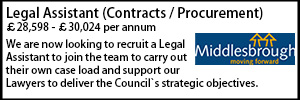Obstruction of the highway
- Details
When is obstruction of the highway lawful? Rachel Baker explains.
Highway authorities have a statutory duty to assert and protect the rights of the public to the use and enjoyment of any highway for which they are the highway authority (Section 130 of the Highways Act 1980) and part of this statutory duty is to try to prevent obstruction of highways.
Highways Act 1980
Part IX of the Highways Act 1980 (“the Act”) relates to the lawful and unlawful interference with highways and streets and Section 137 in that part of the Act states that “if a person, without lawful authority or excuse, in any way wilfully obstructs the free passage along a highway he is guilty of an offence and liable to imprisonment for a term not exceeding 51 weeks or a fine or both”. Previously a person found guilty under this section would only have been liable to a fine but this has since been widened to include imprisonment or both a fine and imprisonment by virtue of the Police, Crime, Sentencing and Courts Act 2022 which amendment came into effect on 12th May 2022 (those amendments only applying to offences under this section committed on or after 12th May 2022).
An obstruction of the highway could include anything which prevents the public from passing and re-passing along the highway but it does not have to extend over the whole width of a highway nor is it necessary to prove that a particular user of the highway was actually obstructed as the offence is the obstruction of the highway rather than users of it.
Highway authorities have numerous statutory powers they can use as regards obstructions both to enable them to remove and/or prosecute any unlawful (or potentially unlawful) obstructions and to licence and allow certain obstructions. It is these latter licensing provisions which make the difference between what is an authorised placement or act on the highway and what, in the absence of a licence/permit, constitutes an obstruction i.e. they give the person ‘lawful authority’ without which they would be committing an offence under s.137 of the Act.
The majority of these statutory powers are contained in the Act (mainly in Part IX) and examples of some of those obstructions on a highway that may be legitimately licensed and controlled by a highway authority under the Act in certain specific circumstances include:
- Control of Builder’s Skips – Sections 139-140A (with proposed additional Sections 140B and 140C pending)
- Restriction of planting of trees, shrubs etc - Sections 141-142
- Control of scaffolding – Section 169
- Control of deposit of building materials and making of excavations in streets – Section 171
- Construction of bridges and buildings over the highway and placing of rails, beams etc. – Sections 176-178
There is however no guarantee that a highway authority will grant a licence when a party applies for one as the authority will need to consider a number of factors including whether there are already obstructions licenced in the same area, whether the highway needs to be kept as free from such obstructions as possible etc.
If such obstructions are not so licensed, the highway authority would usually look to rely for enforcement purposes on the provisions of the relevant section of the Act relating to that obstruction (where it contained enforcement or offence provisions for that specific kind of obstruction) or for other obstructions it would generally look to the provisions of s.137 to prosecute those who have caused the obstruction and/or s.149 of the Act (Removal of things so deposited on highways as to be a nuisance etc) for removal powers for the obstruction. For example, s.137 is often used to prosecute street traders where they have not obtained the necessary permission, licence or consent as appropriate for the activity.
Other powers of removal which a highway authority can use pursuant to the Act for specific types of obstruction include the power to remove structures from highways (under s.143) and the cutting/felling of trees and vegetation that overhang the highway (under s.154).
Other specific offences in the Act relating to obstruction include those relating to road-side sales (s.147A) and penalties for depositing things or pitching booths etc. on the highway (s.148).
In addition to Part IX of the Act, Part VIIA of the Act (Provision of Amenities on Certain Highways) also provides powers (under s.115E) for authorities to grant licences to people in respect of certain activities (specified in s.115B(1)-(3) and s.115C) to be allowed on and also for certain objects and structures to be placed on certain types of highway (essentially those with no vehicular access or usage) which would otherwise constitute an obstruction. These include for the enhancement of amenity (which includes providing lawns, trees, shrubs or flowers), providing a service to benefit the public, providing recreation and refreshment facilities, the production of income, providing an information or advice centre or for advertising.
These powers are often used to allow businesses such as cafes and restaurants to put tables and chairs outside their premises (usually on the pavement) and to allow mobile catering vans to sell food and drink but it should be noted there has been a recent change (31st March 2024) to the scope of s.115E as mentioned below.
Other powers
Similar but separate powers in respect of licensing of certain activities on the highway were granted to local authorities during the Covid-19 pandemic, by virtue of Part 1 of the Business and Planning Act 2020 (BPA 2020) which created a temporary procedure to enable businesses such as cafes, pubs etc to apply for a temporary licence, known as a pavement licence, to allow them to put removable tables and chairs and similar furniture outside their premises on the highway (again it must be non-vehicular highway) for customer usage.
However, by virtue of The Levelling-up and Regeneration Act 2023 (Commencement No. 3 and Transitional and Savings Provision) Regulations 2024, Section 229 and Schedule 22 of the Levelling-up and Regeneration Act 2023 have recently been brought into force (31st March 2024) and amend BPA 2020 to make the temporary procedure introduced during the pandemic permanent (subject to various amendments and saving provisions) and also amend s.115E of the Act so that a local authority may not under that section “grant a person permission to do anything which is capable of being authorised by a pavement licence under section 1 of the Business and Planning Act 2020”.
Finally, other specific offences created by legislation other than the Act which may be of interest and relate to obstruction of the highway by vehicles includes Section 22 of the Road Traffic Act 1988 which provides that “If a person in charge of a vehicle causes or permits the vehicle or a trailer drawn by it to remain at rest on a road in such a position or in such condition or in such circumstances as to involve a danger of injury to other persons using the road, he is guilty of an offence” and Part 2 of the Clean Neighbourhoods and Environment Act 2005 which creates two ‘nuisance parking offences’ of exposing vehicles for sale on a road or repairing vehicles on a road.
Summary
This article covers just some examples of the provisions of Part IX of the Act and other Acts which are available to a highway authority to deal with and/or to licence obstructions but there are numerous others.
A highway authority also has a common law duty to prevent and remove obstructions on the highway and it should be borne in mind that the powers conferred for example by the relevant sections in Pt IX of the Act do not prejudice or affect their common law powers and duties, as provided for in s.333(1) of the Act i.e. “No provision of this Act relating to obstruction of or other interference with highways is to be taken to affect any right of a highway authority or other person under any enactment not contained in this Act, or under any rule of law, to remove an obstruction from a highway or otherwise abate a nuisance or other interference with the highway, or to affect the liability of any person under such an enactment or rule to proceedings (whether civil or criminal) in respect of any such obstruction or other interference”.
Rachel Baker is a Lawyer at the Planning & Highways Team at Pathfinder Legal Services.
Sponsored articles
Walker Morris supports Tower Hamlets Council in first known Remediation Contribution Order application issued by local authority
Unlocking legal talent
Lawyer (Planning and Regulatory)
Legal Director - Government and Public Sector
Contracts Lawyer
Locums
Poll









































